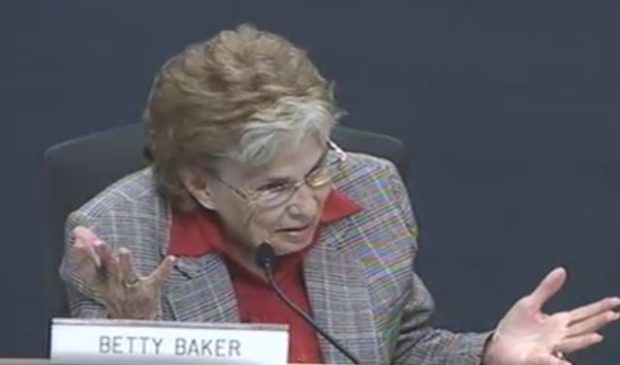Baker: historic preservationist, zoning queen
Tuesday, January 31, 2017 by
Jo Clifton Betty Baker, once known as Austin’s Queen of Zoning, died in her sleep Monday morning, according to longtime friends. Jerry Rusthoven, acting assistant director of the Planning and Zoning Department, told the Austin Monitor that Baker would have been 84 today. She had been ill for some time.
Baker retired two years ago as the first chair of the city’s Zoning and Platting Commission, a post she held for 14 years. That service followed her tenure on the Planning Commission, where she served as a member and then as chair for many years prior to City Council’s decision to split the two commissions.
Rusthoven remembers that when he came to the city in 1994, Baker was considered to be the godmother of the Planning Department. “She served as my mentor. She not only taught me planning, but she taught me how things are done here. When you’re fresh out of school and you’re sitting there with some developer attorney yelling at you … or you’ve got some neighborhood person in your face – when you’re green like that – you don’t know how to handle it. And Betty taught me how to handle it. All of that was really helpful,” he said.
Like many who have worked with Baker, Rusthoven noted, “She could be caustic and somewhat abrasive, and she even did it at work, to us. But usually it was because you messed something up, but you knew she was doing it to make you a better employee or a better person. She wasn’t afraid to let you know you screwed up.” He said not everyone understood her motivation, but she was demanding for a good reason.
Baker put in many years promoting historic preservation, both at the city of Austin and at the Austin Convention & Visitors Bureau. At the city, she was the chief author of Austin’s historic preservation program.
At the ACVB, she worked to promote tourism at Austin’s historic sites. And it is for her work on historic preservation that we think Baker would like to be remembered, especially for her devotion to the preservation of Austin’s Moonlight Towers, the only ones left in the world.
Although she retired from the visitors bureau in 2007, Baker continued her service as chair of the ZAP until her retirement from that commission in 2015.
This is how Amy Smith, former managing editor for news at the Austin Chronicle, described Baker’s rise to power in a 2004 story:
“A single mother, Baker took a job in August 1974 as a stenographer in the city’s planning department. Before long, she was doing the work of a planner and serving as the staff liaison to the Historic Landmark Commission. When a planning position opened up, she applied, but was turned down for lack of a college degree. She asked for a transfer to another department. ‘Would she train the new hire before leaving?’ she was asked. ‘Uh, no,’ came the response. The position was reposted – this time as a planning technician – and the job went to Baker. That experience would change Baker forever. ‘It made me more determined,’ she said. ‘I was determined to do the job better than anybody else.’ Within a year, she was promoted to city planner.
“There are any number of Austin streets that Baker can drive down while pointing out a development, a historic structure, or a vacant lot that she had a hand in when the case was wending its way through the city process. Her work on the historic zoning of the Moonlight Towers led her to a 98-year-old woman named Annie Hill, who remembered the day the city hauled the moonlight tower over on an ox cart and erected the wrought-iron pillar just beyond her property on Nueces Street. …
“There are hundreds of other similar landmarks, each bearing Baker’s invisible signature.”
Rusthoven concluded, “She wasn’t afraid to tell people what she thought … was the right thing to do. … Sometimes it came across as harsh, but I think she was really, really committed to making this the city that we love.”
Her friend, former Mayor Pro Tem Betty Dunkerley, said, “She had so much knowledge and experience with zoning and other city functions, and she was willing to share that with anybody who wanted to know about it.”
She is survived by her daughter, Brynda, and several grandchildren.
The Austin Monitor’s work is made possible by donations from the community. Though our reporting covers donors from time to time, we are careful to keep business and editorial efforts separate while maintaining transparency. A complete list of donors is available here, and our code of ethics is explained here.
You're a community leader
And we’re honored you look to us for serious, in-depth news. You know a strong community needs local and dedicated watchdog reporting. We’re here for you and that won’t change. Now will you take the powerful next step and support our nonprofit news organization?











